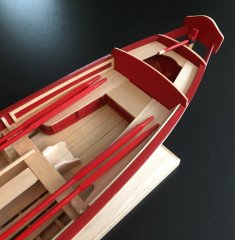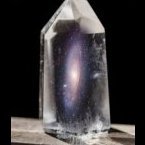
JerseyCity Frankie
-
Posts
1,338 -
Joined
-
Last visited
Reputation Activity
-
 JerseyCity Frankie got a reaction from popeye the sailor in HMS VICTORY by Kevin - FINISHED - Caldercraft - 1/72
JerseyCity Frankie got a reaction from popeye the sailor in HMS VICTORY by Kevin - FINISHED - Caldercraft - 1/72
You should be very proud of this HMS Victory Model, it looks really good. Particularly the color of the ship and the overall texture of the rigging. The colors of the deck hull and fittings are very convincing and look very natural. I know there’s now a lot of push/pull about the historic color of the hull stripes but for me Victory will always have the buttery yellow colors you have selected.
-
 JerseyCity Frankie got a reaction from popeye the sailor in HMS VICTORY by Kevin - FINISHED - Caldercraft - 1/72
JerseyCity Frankie got a reaction from popeye the sailor in HMS VICTORY by Kevin - FINISHED - Caldercraft - 1/72
The Chestree has nothing to do with the anchor, they are fairleads for the Tacks. There should be a hole bored through them from fore to aft for the line to reave through, and another hole bored through the hull adjacent to them that leads the Tack inboard to the Gundeck where it belays on a kevel or huge cleat.The two vertical paralel wooden “fenders” are actually used for Parbuckling casks and barels aboard, the barels role up the ships side and the two wooden tracks give a smooth surface to roll on. Here’s a simplified example of how it works. I scincearly hope the boat dropping off the stores rows out from under when they begin lifting. On a ship the size of Victory it must have been quite a task.
-
 JerseyCity Frankie got a reaction from Piet in HMS VICTORY by Kevin - FINISHED - Caldercraft - 1/72
JerseyCity Frankie got a reaction from Piet in HMS VICTORY by Kevin - FINISHED - Caldercraft - 1/72
You should be very proud of this HMS Victory Model, it looks really good. Particularly the color of the ship and the overall texture of the rigging. The colors of the deck hull and fittings are very convincing and look very natural. I know there’s now a lot of push/pull about the historic color of the hull stripes but for me Victory will always have the buttery yellow colors you have selected.
-
 JerseyCity Frankie got a reaction from mtaylor in HMS VICTORY by Kevin - FINISHED - Caldercraft - 1/72
JerseyCity Frankie got a reaction from mtaylor in HMS VICTORY by Kevin - FINISHED - Caldercraft - 1/72
You should be very proud of this HMS Victory Model, it looks really good. Particularly the color of the ship and the overall texture of the rigging. The colors of the deck hull and fittings are very convincing and look very natural. I know there’s now a lot of push/pull about the historic color of the hull stripes but for me Victory will always have the buttery yellow colors you have selected.
-
 JerseyCity Frankie got a reaction from Piet in HMS VICTORY by Kevin - FINISHED - Caldercraft - 1/72
JerseyCity Frankie got a reaction from Piet in HMS VICTORY by Kevin - FINISHED - Caldercraft - 1/72
The Chestree has nothing to do with the anchor, they are fairleads for the Tacks. There should be a hole bored through them from fore to aft for the line to reave through, and another hole bored through the hull adjacent to them that leads the Tack inboard to the Gundeck where it belays on a kevel or huge cleat.The two vertical paralel wooden “fenders” are actually used for Parbuckling casks and barels aboard, the barels role up the ships side and the two wooden tracks give a smooth surface to roll on. Here’s a simplified example of how it works. I scincearly hope the boat dropping off the stores rows out from under when they begin lifting. On a ship the size of Victory it must have been quite a task.
-
 JerseyCity Frankie got a reaction from EricWilliamMarshall in Books on model ship building
JerseyCity Frankie got a reaction from EricWilliamMarshall in Books on model ship building
I believe the topic was book recommendations? ....... the Neophyte Shipmodelers Jackstay by GF Campbell is my recommendation. This slim volume is a good place to start if you want to invent the wheel for yourself and begin learning ship model building from the very beginning. The reason it’s perfect for the beginner is that it has some of the best clear uncomplicated illustrations you will ever see. Plus it doesn’t go down the rabbit hole in any one issue, it stays simple and covers the basics in a straightforward and efficient style. It covers all the necessary topics yet remains uncomplicated. Finally it’s inexpensive and easily obtainable in the secondhand market.
-
 JerseyCity Frankie reacted to Kevin in HMS VICTORY by Kevin - FINISHED - Caldercraft - 1/72
JerseyCity Frankie reacted to Kevin in HMS VICTORY by Kevin - FINISHED - Caldercraft - 1/72
Thank you for the info, i looked up the references for the chesstrees last night and found what they were for, LOL gutted that i had missed it in the first place, but very happy that it was spotted, i scratched one last night, and will fit it this weekend
as for the colours, i was never ever going to paint her in the pink shade, and still find it had to believe that was one of the top coats used
the rigging thread although very poor in quality had been dipped in Flory Models clay based wash and then waxed, different shades has allowed me to show it not looking pristine
the wooded decks were just brushed with a water based matt varnish
the tiles im not sure what to do with, most likely i will buff them up again after the rudder is fitted, and then tone it down with a diluted salt wash and then possibly a green wash, but no intentions of her staying that bright
-
 JerseyCity Frankie got a reaction from mort stoll in HMS VICTORY by Kevin - FINISHED - Caldercraft - 1/72
JerseyCity Frankie got a reaction from mort stoll in HMS VICTORY by Kevin - FINISHED - Caldercraft - 1/72
You should be very proud of this HMS Victory Model, it looks really good. Particularly the color of the ship and the overall texture of the rigging. The colors of the deck hull and fittings are very convincing and look very natural. I know there’s now a lot of push/pull about the historic color of the hull stripes but for me Victory will always have the buttery yellow colors you have selected.
-
 JerseyCity Frankie got a reaction from mtaylor in HMS VICTORY by Kevin - FINISHED - Caldercraft - 1/72
JerseyCity Frankie got a reaction from mtaylor in HMS VICTORY by Kevin - FINISHED - Caldercraft - 1/72
The Chestree has nothing to do with the anchor, they are fairleads for the Tacks. There should be a hole bored through them from fore to aft for the line to reave through, and another hole bored through the hull adjacent to them that leads the Tack inboard to the Gundeck where it belays on a kevel or huge cleat.The two vertical paralel wooden “fenders” are actually used for Parbuckling casks and barels aboard, the barels role up the ships side and the two wooden tracks give a smooth surface to roll on. Here’s a simplified example of how it works. I scincearly hope the boat dropping off the stores rows out from under when they begin lifting. On a ship the size of Victory it must have been quite a task.
-
 JerseyCity Frankie got a reaction from cog in Books on model ship building
JerseyCity Frankie got a reaction from cog in Books on model ship building
I believe the topic was book recommendations? ....... the Neophyte Shipmodelers Jackstay by GF Campbell is my recommendation. This slim volume is a good place to start if you want to invent the wheel for yourself and begin learning ship model building from the very beginning. The reason it’s perfect for the beginner is that it has some of the best clear uncomplicated illustrations you will ever see. Plus it doesn’t go down the rabbit hole in any one issue, it stays simple and covers the basics in a straightforward and efficient style. It covers all the necessary topics yet remains uncomplicated. Finally it’s inexpensive and easily obtainable in the secondhand market.
-
 JerseyCity Frankie reacted to Roger Pellett in Books on model ship building
JerseyCity Frankie reacted to Roger Pellett in Books on model ship building
The two volume Shop Notes published by the Nautical Research Guild are worth owning.
Roger
-
 JerseyCity Frankie reacted to mtaylor in Building and rigging Cannon Help
JerseyCity Frankie reacted to mtaylor in Building and rigging Cannon Help
When in doubt, do what a lot of do... use the search function to find other builds of the same kit. Often different builders will have different ways of doing the same thing depending on their skills and experience. It saves a lot of head scratching and missteps.
-
 JerseyCity Frankie reacted to Blue Ensign in HM Cutter Cheerful 1806 by Blue Ensign - FINISHED - Syren Ship Model Company - 1:48 scale
JerseyCity Frankie reacted to Blue Ensign in HM Cutter Cheerful 1806 by Blue Ensign - FINISHED - Syren Ship Model Company - 1:48 scale
Thank you guys,
@ John - only minor use was needed, and I also wore a mask.
Post 72
Completing the guns. (Part 1)
The first job is to apply the Royal monograms, using Chuck's delightful little offerings.
6208
A small detail that is missing from the guns are the vents, quite feasible to add at 1:48 scale.
Easy enough to replicate on the long guns with a strip of brass drilled with a hole, but more difficult on the Carronades where the touch hole is in a casting atop the base rings.
6210
6211
I wouldn't have attempted this freehand but it can be done using the mill with a 0.5mm micro drill.
Alternatively a small patch of 'lead' foil could be used to represent the covers to protect the touchhole.
6217
The blackening process is fairly slow because after each treatment tiny contaminated areas remain that require more delicate cleaning before re-dipping.
6230
However little by little an even finish is obtained.
6220
Here's a completed carronade after a light buff with a soft paintbrush.
6225
Once the cover is even the guns can be re dipped to intensify the depth of colour.
6254
Slightly darker after a further dip.
6247(2)
The completed set
The next step is to mount the guns, and that's a whole new exercise in fiddly detail.
B.E.
22/02/2019
-
 JerseyCity Frankie reacted to Kevin in HMS VICTORY by Kevin - FINISHED - Caldercraft - 1/72
JerseyCity Frankie reacted to Kevin in HMS VICTORY by Kevin - FINISHED - Caldercraft - 1/72
Good afternoon everyone
i hope to have the foremast completed today, but each time i put a line in the Longbridge book shows another,
-
 JerseyCity Frankie reacted to Kevin in HMS VICTORY by Kevin - FINISHED - Caldercraft - 1/72
JerseyCity Frankie reacted to Kevin in HMS VICTORY by Kevin - FINISHED - Caldercraft - 1/72
this my next build 1/30 St Nectan
-
 JerseyCity Frankie got a reaction from John Allen in Getting a tight finish to a rope
JerseyCity Frankie got a reaction from John Allen in Getting a tight finish to a rope
When cut, the ends of the rope are going to Unlay no matter how much twist. Depending on the material you use some rope will unlay more than others. In scale models the Whipping winds up being dipping the end in glue. Synthetic line can be cut with a hot knife and this heat melts the fibers at the cut. But if you want Historical Acuracy you will have to put a Whipping on the end of the line, which is what is done in full size practice. Whipping is done with a needle and thread, look up “sailmakers Whipping “ and “common Whipping”.
-
 JerseyCity Frankie got a reaction from mtaylor in Getting a tight finish to a rope
JerseyCity Frankie got a reaction from mtaylor in Getting a tight finish to a rope
When cut, the ends of the rope are going to Unlay no matter how much twist. Depending on the material you use some rope will unlay more than others. In scale models the Whipping winds up being dipping the end in glue. Synthetic line can be cut with a hot knife and this heat melts the fibers at the cut. But if you want Historical Acuracy you will have to put a Whipping on the end of the line, which is what is done in full size practice. Whipping is done with a needle and thread, look up “sailmakers Whipping “ and “common Whipping”.
-
 JerseyCity Frankie got a reaction from Tigersteve in Model shipways flying fish
JerseyCity Frankie got a reaction from Tigersteve in Model shipways flying fish
No need to bend anything. Flip the model upside down on a big sheet of paper or card and trace carefully the outermost extent of all the frames/bulkheads. This line represents the outboard edge of the waterway. On your paper copy you then draw the inner edge of the waterway parallel and inside of the first line, as wide as your waterway is going to be. Note that you really need just one side of the ship as the symmetry should assure that one line works for both sides. Now cut out your paper waterway- it will be a long curved ribbon. Lay it onto the model to see if it fits and if it doesn’t fit perfectly cut it with scissors and patch it with tape until it’s perfect. Lay this pattern piece onto sheet stock (available wherever fine basswood is sold at craft stores) and cut with x-acto knife. Flip the pattern piece upside down and cut the other waterway. Glue.
-
 JerseyCity Frankie got a reaction from mtaylor in Optimal Bowsprit Angle
JerseyCity Frankie got a reaction from mtaylor in Optimal Bowsprit Angle
This has all the makings of a fascinating lecture. I could imagine someone trying to document the degree of Bowsprit Steeve on every vessel for which data can be obtained and then build a presentation that would show the many influences that would arise over time to guide the shipwrights decisions about the angle. Factors as mentioned above by Henry. Whenever I’ve gotten involved with a sailing vessel I’m always eventually reminded how every individual part of the vessel is subtly effected by every other part of the boat. You can’t isolate anything aboard and say that it’s independent. If you perform some task at one end of the ship it will have subtle effects all over the rest of the boat.
-
 JerseyCity Frankie got a reaction from popeye2sea in Optimal Bowsprit Angle
JerseyCity Frankie got a reaction from popeye2sea in Optimal Bowsprit Angle
This has all the makings of a fascinating lecture. I could imagine someone trying to document the degree of Bowsprit Steeve on every vessel for which data can be obtained and then build a presentation that would show the many influences that would arise over time to guide the shipwrights decisions about the angle. Factors as mentioned above by Henry. Whenever I’ve gotten involved with a sailing vessel I’m always eventually reminded how every individual part of the vessel is subtly effected by every other part of the boat. You can’t isolate anything aboard and say that it’s independent. If you perform some task at one end of the ship it will have subtle effects all over the rest of the boat.
-
 JerseyCity Frankie got a reaction from J11 in Furled sails
JerseyCity Frankie got a reaction from J11 in Furled sails
The problem with being literal and folding an actual scale sail which is made of fabric and the correct size and shape, is that due to the nature of the woven material it can never be folded as tightly or make as small a bundle as an actual sail on a real ship. The fabric can not be compacted down to the scale size and the wrinkles you get will also be hugely out of scale. I suggest tissue paper moistened with white glue and water and then formed into the correct size bundles then painted or lightly stained to look like sailcloth. When dry this stuff is very convincing as it has the organic look of an actual fabric bundle and it even has tiny little wrinkles.
-
 JerseyCity Frankie got a reaction from J11 in Rigging Tightness
JerseyCity Frankie got a reaction from J11 in Rigging Tightness
By the way, I mentioned knots above. In my opinion the best knot for a temporary and adjustable knot to tie on say, a backstays, is the Rolling Hitch. Take the backstays down to the lower deadeye or whatever then around and up and tie a Rolling Hitch back on itself. It's a knot that will hold where you put it but one which you can easily adjust by sliding back and forth on whatever you hitched it to, without having to losen or untie or make any adjustments to the knot itself. You need to leave the backstays and all other standing rigging you want to be adjustable longer than necessary in order to have enough extra line to tie an adjustable knot in the end. The Rolling Hitch is ludicrously easy to learn and tie.
-
 JerseyCity Frankie got a reaction from J11 in Rigging Tightness
JerseyCity Frankie got a reaction from J11 in Rigging Tightness
Things go badly when model rigging line is too tight. Certainly standing rigging shouldn't droop MUCH, But it should not be made as tight as it's possible to tighten it. Also, what you will discover as you rig is that tension set into one part of the rig at the beginning of the work is going to trouble you later over on another part of the rig.It's best to get ALL the stays and backstays on the completed masts BEFORE you set up all the tension. You are going to have to tune the rig at the end to get all the masts in line and not leaning one way and another, and you won't be able to make any adjustments if you cement every rope end in place as you work your way up. Tie the stays and backstays with knots you can untie and adjust at the final stage of rigging. THEN make them permanent only after you have sighted down the centerline of the model AND gauged the rake of all the masts. This advice will seam overblown as you are working on the lower rigging. But as you go higher the thinner spars are very flexible and they WILL bend in ways you do not want them to so keep all your tensioning options open until the last minute.
-
 JerseyCity Frankie got a reaction from pontiachedmark in Model shipways flying fish
JerseyCity Frankie got a reaction from pontiachedmark in Model shipways flying fish
No need to bend anything. Flip the model upside down on a big sheet of paper or card and trace carefully the outermost extent of all the frames/bulkheads. This line represents the outboard edge of the waterway. On your paper copy you then draw the inner edge of the waterway parallel and inside of the first line, as wide as your waterway is going to be. Note that you really need just one side of the ship as the symmetry should assure that one line works for both sides. Now cut out your paper waterway- it will be a long curved ribbon. Lay it onto the model to see if it fits and if it doesn’t fit perfectly cut it with scissors and patch it with tape until it’s perfect. Lay this pattern piece onto sheet stock (available wherever fine basswood is sold at craft stores) and cut with x-acto knife. Flip the pattern piece upside down and cut the other waterway. Glue.
-
 JerseyCity Frankie got a reaction from mtaylor in Optimal Bowsprit Angle
JerseyCity Frankie got a reaction from mtaylor in Optimal Bowsprit Angle
I imagine the pitching motion of the ship is effected most by waterline length, the longer the waterline length ( or maybe call it Beam to Length ratio) the less pitching. It seams to me that the more modern a ship, the more shallow the Steev of the Bowsprit. And I’m guessing-GUESSING- this is due to the greater hull lengths achieved through time. Older ships appear to have much steeper Bowsprits? However the cutter rig appears to always have a very shallow Bowsprit despite a short Beam to Length ratio. But cutter headrigs are very odd things...




.thumb.jpeg.fc5d633a7b34428fcf19419a73d56d55.jpeg)





